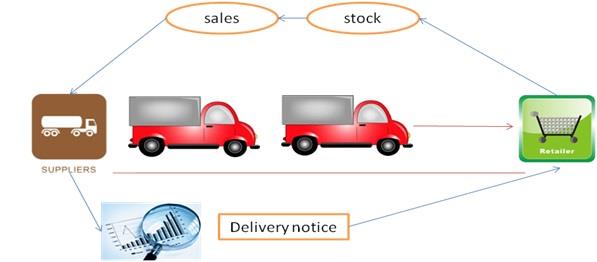- Business Concepts ›
- Operations and Supply Chain ›
- Continuous Replenishment
Continuous Replenishment
Definition & Meaning
This article covers meaning & overview of Continuous Replenishment from operations perspective.
What is meant by Continuous Replenishment?
It’s a supply chain strategy in which frequent replenishment takes place from the supplier to the retailer or distributor in order to maintain better flow in supply chain and minimize bullwhip effect. It’s a kind of Vendor Managed Inventory (VMI) system where the decision of quantity and time to replenish lies with supplier and not the retailer. But such moves need agreement between supplier and retailer. Also Continuous replenishment is a misnomer; it’s not continuous but frequent replenishment.
In order to implement continuous replenishment (CR), supplier needs to set an objective i.e. fill rate etc. Also supplier needs to implement IT systems to establish real time flow of information in the supplier chain about sales e.g. distribution center withdrawals, retailer’s point of sales etc. These data are important to predict normal sales and deviations in demand, based on which inventory level is decided. This strategy also needs agreement on promotions.
The system itself suggest on how much to replenish time to time. The associated benefits of CR are reduced inventory, reduced stock out, minimization of bullwhip effect, improved customer service, reduced administration cost and enhanced perception value in trading partner. One of the concerns is about maintaining full truckload and transportation cost efficiency as replenishment quantity becomes smaller. But it can be minimized by using smaller trucks or loading more variety per truck.

Figure 1 Continuous Replacement
Hence, this concludes the definition of Continuous Replenishment along with its overview.
This article has been researched & authored by the Business Concepts Team which comprises of MBA students, management professionals, and industry experts. It has been reviewed & published by the MBA Skool Team. The content on MBA Skool has been created for educational & academic purpose only.
Browse the definition and meaning of more similar terms. The Management Dictionary covers over 1800 business concepts from 5 categories.
Continue Reading:
What is MBA Skool?About Us
MBA Skool is a Knowledge Resource for Management Students, Aspirants & Professionals.
Business Courses
Quizzes & Skills
Quizzes test your expertise in business and Skill tests evaluate your management traits
Related Content
All Business Sections
Write for Us